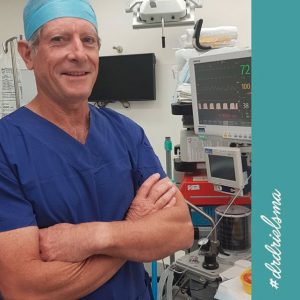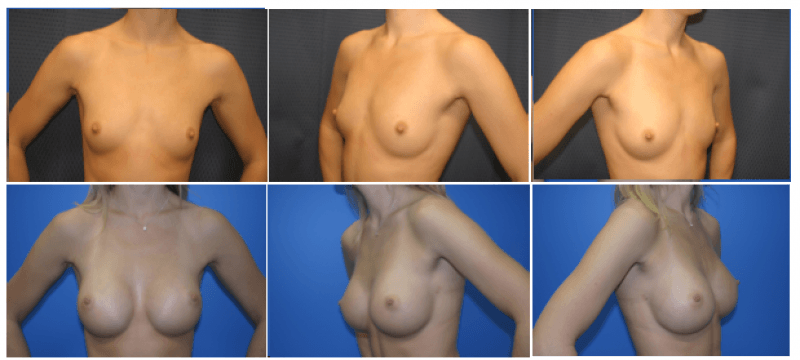Warning: Undefined array key "target" in /home/sh10236/public_html/wp-content/themes/drdrielsma/functions.php on line 72
Warning: Undefined array key "target" in /home/sh10236/public_html/wp-content/themes/drdrielsma/functions.php on line 72
Breast augmentation mammoplasty or breast implants is a procedure to increase breast size and shape by inserting breast implants. Breast augmentation mammoplasty can also improve cleavage and help to correct uneven or misshapen breasts.

Breast augmentation mammoplasty – also known as Breast Enlargement or augmentation mammoplasty, – enlarges the breast using breast implants. It is a very popular and common surgery.
Your procedure will involve choosing appropriately sized implants to suit your preferred size and shape. Nipple and breast lift (mastopexy) surgeries are often combined with breast augmentation mammoplasty again to increase size of the result. You may also like to explore fat grafting to your breasts in combination with breast augmentation mammoplasty, breast lift (mastopexy) or nipple surgery, depending on your desired result. This can be discussed thoroughly with Dr Drielsma during your consultation.
Patients may see many changes following breast augmentation mammoplasty, including:
- Larger, fuller breasts
- Defined cleavage
- Improvement in breast ptosis
- Improved breast symmetry, tuberous breasts or other genetic concerns
Your breast augmentation mammoplasty procedure will be suited your specific needs. However, all surgeries will take into account the following:
- Your existing breast tissue
- Position of the breast and nipple
- The health and elasticity of your breasts
- Your underlying chest muscles
- Desired shape and size
- Your choice of implant size, shape, and type
Breast Implant Options
Did you know there are a variety of breast implant options when you are seeking a breast augmentation mammoplasty? You have the choice between silicone or saline implants, and round or anatomically shaped.
Saline implants are often described as having a “water bed” feel. Some even report a slight ripple effect that can be seen through the skin. This can be remedied to an extent by using smooth surfaced, round implants that are overfilled (within manufacturer specifications) creating a firmer feel. Should an implant rupture, it will deflate and the saline easily absorbed by the body.
Silicone implants have a lower incidence of rippling than saline implants thanks to the consistency of silicone gel. They have a natural feel, designed to mimic breast tissue. However, unlike saline implants, silicone implants will not be absorbed by the body and can cause issues with hardening of the breast or capsule contracture.

Breast implants come in a range of shapes and sizes, meaning you can choose almost any size for your breasts. This range of choice means you and your surgeon can together choose the best size for your body and desires.
Breast implants also come in different shapes – round and anatomical.
Round implants have the advantage that should they rotate in the breast pocket, the breast shape won’t be affected. Anatomically shaped or “tear drop” shaped breast implants have the advantage of giving a more natural look by enhancing the lower pole of the breast while reducing the bulge of the upper pole of the breast. However, if an anatomical implant rotates in the breast pocket, breast shape is affected and it will need to be repositioned to restore the correct appearance.
What About Breast Augmentation Mammoplasty Scarring?
You must remember that all surgery will result in scarring in one form or another. Breast Augmentation surgery is no different. Your level of scarring will depend on a variety of factors, including incision methods and genetic disposition to scarring.
Breast Augmentation Mammoplasty Before and After Gallery
Women may choose to undergo breast augmentation surgery for a number of different reasons.
BEFORE AND AFTER PHOTOSBreast Augmentation Mammoplasty Surgery Sydney
Dr Robert Drielsma is a Sydney plastic surgeon, with experience in breast augmentation mammoplasty surgery. Dr Drielsma is available at Bondi Junction, Camden, Wagga Wagga and Canberra.
If you would like more information on breast augmentation mammoplasty and your options, or if you would like to book a consultation with Dr Drielsma please call 1800 180 777.
Breast Augmentation Mammoplasty FAQ
What Downtime is There for Breast Augmentation Mammoplasty Surgery?
When will I see Results?
What Complications are There?
BREAST IMPLANT COMPLICATIONS
Breast implants are not intended to be lifetime devices, with an estimated lifespan of 10 to 15 years. The risk of adverse events begins to accumulate as soon as the implants are inserted.
Although many women with breast implants will not experience any issues, there are some common and some less common complications that can occur. In 2019, the 3 most common complications for revision surgery were capsular contracture (37%), implant rupture (23%) and implant malposition (19%).
Women with breast implants are recommended to have reviews very 2 years with their surgeon or GP to assess for complications for the duration of the breast implant.
Capsular Contracture
Capsular contracture occurs when scar tissue that normally forms around the implant tightens and squeezes the implant resulting in progressive hardening, distortion and deformity of the breast. Severe capsular contracture can cause secondary implant rupture.
Capsular contracture is graded clinically using the Baker classification.
BAKER GRADE DESCRIPTION 1 Implant is soft and is not palpable and/or visible. 2 Implant is palpable, but no visible deformity. 3 Implant is hard, palpable and with some minor visibility (e.g. puckering, rippling, change in shape). 4 Implant is very hard and painful with significant deformity of breast and/or malposition. Capsular contracture can cause breast asymmetry, hardness and distortion and may require a secondary, corrective procedure – implant removal or replacement.Advanced capsular contracture with thick scar tissue surrounding a ruptured breast implant – explanted after 15 years
Breast Implant Rupture
All breast implants have an outer shell that can potentially develop a tear or hole i.e. a rupture. The risk of implant rupture increases as the implant ages and 50% of implants will show signs of loss of integrity at 10 years after surgery.
Implant rupture are classified into intracapsular and extracapsular rupture.
- Intracapsular rupture means the implant has ruptured inside the tissue capsule which the body has formed around the implant. Intracapsular rupture is usually asymptomatic, meaning the breast and implant looks and feels normal. It is usually diagnosed incidentally on an ultrasound performed for other reasons.
- Extracapsular rupture means the silicone has broken through the tissue capsule which the body has formed around the implant, and silicone can spread into the breast tissue or surrounding muscle. Extracapsular rupture can also be asymptomatic (known as silent rupture), but may result in breast pain, lumps in the breast or armpit or a change in size and shape of the breast.
An intracapsular rupture will eventually progress into an extracapsular rupture, but the rate of progression is unpredictable.
Implant rupture can be detected on ultrasound, and confirmed by MRI.
Ruptured implants can interfere with breast screening. Silicone deposits in the breast tissue may mask an underlying breast cancer. Mammograms may worsen the implant rupture due to pressure applied to the implant.
Generally, it is recommended that ruptured implants be removed.
Implant Malposition
The implant may move from its original pocket resulting in various deformities. This includes the double-bubble deformity, where the implant drops below the inframammary fold.
Breast Implant Cancer (BIA-ALCL)
Breast Implant Associated Anaplastic Large Cell Lymphoma (BIA-ALCL) is a rare cancer of the immune system that occurs only in women with breast implants. It is not breast cancer, but rather a type of lymphoma that grows in the tissue capsule which the body has formed around the implant.
The risk of BIA-ALCL is estimated to be between 1 in 1000 and 1 in 10000, meaning 1 woman will be diagnosed with BIA-ALCL for every 1000 to 10000 women with breast implants.
All Australian cases have occurred in women with textured implants (and no cases in women with smooth implants as of January 2020). The risk of BIA-ALCL is significantly higher for “macro” textured (e.g. Silimed Polyurethane, Allergan Biocell) compared to “micro” textured (e.g. Mentor Siltex) implants. BIA-ALCL occurs with both saline and silicone implants. There is no difference in risk in women who have implants for breast augmentation or reconstruction.
The main symptoms of BIA-ALCL are persistent breast swelling or pain. It can also present as a lump in the breast or armpit. Most cases occur between 3 and 14 years after surgery.
The first line investigation is a breast ultrasound to assess for the presence of fluid. If fluid is present, a sample will be taken to look for cancerous cells. Fluid collections (seroma) is common after breast implants and most are not BIA-ALCL. Mammograms are not helpful for the diagnosis.
Most patients with BIA-ALCL are cured by complete removal of the intact capsule with the implant contained inside, a technique known as total intact capsulectomy (or en-bloc capsulectomy).
It is currently not recommended that breast implants be removed in women without any symptoms. This is because:
- BIA-ALCL is considered relatively rare
- BIA-ALCL has a high rate of cure once diagnosed
- Any surgery and anaesthetic has risks
What is the Cost of Breast Augmentation Mammoplasty?
The cost of breast augmentation mammoplasty varies from patient to patient and surgeon to surgeon, depending on what you want to achieve with your augmentation mammoplasty. It is important that you always do your homework when looking for a Specialist Plastic Surgeon. You should be happy with the quality of service and the experience of your chosen surgeon for the price of surgery you are being offered.
What About Breast Screening?
What Should I Bring to my Consultations?
What about BIA ALCL that is in the news at the moment ?
BIA ALCL or Breast Implant Associated Anaplastic Large Cell Lymphoma is a rare form of cancer involving breast capsule tissue. It is not like common breast cancer. Its incidence and cause continues to be debated around the world but it is very rare, affecting around one in 4,000 to 10,000 woman who have certain types of breast implants. For a detailed statement from ASAPS on this condition as we presently understand it, follow this link.
For the latest information on BIA ALCL you can also look at the TGA Breast Implant Hub
NEXT STEP: Book your Initial Consultation
- Call on 1800 180 777 to arrange your surgeon consultation appointment.
- A Referral from your GP or specialist is now required for all cosmetic surgery – you can’t have a consultation without a Referral.
- 2 consultations are now required before you can book surgery. This process will be explained to you by Dr Drielsma’s staff.
- We require the consultation fee of $350 to be pre-paid in order to make your booking.
What to Bring to your Surgeon Consultation
- Bring a friend or relative to help discuss the information and consider your choices
- Take lots of notes and read the documents provided thoroughly
- You may need to undress for a physical exam so wear simple clothing





